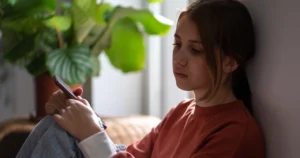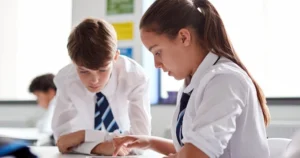Dealing with sexting
If your child has sent or received a nude, get advice on what support you can expect from organisations and what you can do to deal with sexting.
 Close video
Close video
Quick tips
5 things you need to know about dealing with sexting
Most young people don’t see sexting as a problem and are reluctant to talk to adults about dealing with it because they’re afraid of being judged or having their phones taken away. If your child has shared an explicit photo or video of themselves they may be very upset, especially if it’s been widely circulated.
If you become aware of this, try to stay calm and reassure them that they have your support. Let them know you’ll help them deal with sexting by taking the following steps:
Ask your child who they shared the content with first, who passed it on next, and whether someone shared it to cause harm or as a joke that went wrong.
Social networking sites should remove an image if asked. If the image has been shared via a mobile phone, contact the provider who should be able to provide you with a new number.
If your child calls Childline to report the image, Childline works with the Internet Watch Foundation to remove all known copies of the image from the internet.
Your child’s school will be able to help you deal with the repercussions and support your child at school. If other children at the school have shared the image, the school should have a process to handle it and can help stop the image from spreading further
If you suspect an adult has received the image, contact the Child Exploitation and Online Protection Centre (CEOP), the national police lead for online child sexual exploitation.
- What is online sexual harassment?
- Where to go for help
- Videos to watch together
- Recommended resources
What is online sexual harassment?
Online sexual harassment is described as ‘unwanted sexual conduct on any digital platform and is seen as a form of sexual violence. It can include a range of behaviours that use content online (images, messages, posts or videos) on number of platforms.
It can make young people feel:
- Threatened
- Exploited
- Coerced
- Humiliated
- Upset
- Sexualised
- Discriminated against
According to Childnet’s Project deSHAME report, online sexual harassment is taking place between young people as almost a third of girls ages 13-17 years (31%) have received unwanted sexual messages online from their peers (compared to 11% of boys) in the last year.
How can you support young people dealing with sexting?
Reassure your child that they come talk to you or a trusted adult or organisations like Childline to get confidential support. The Mix provide a support helpline for under 25s and Stonewall also offer advice to young lesbian, gay, bi and trans people to help them find local services. Advise your child to report it if they see it. Tell them not to go along with it but call it out if it happens
Where to go for help
If you are concerned and need help dealing with the sexting issue with your child, here is a list of organisations that can support you.
- Information for children, adults or teachers on staying safe on the internet
- Internet Watch Foundation – provide support to removes explicit images or videos of children
- Police helpline – 101 for non-emergency support
- Parent Protect helpline 0808 1000 900 – works to prevent child abuse
- Contact Childline online or 0800 1111
Videos to watch together
You can share these videos with your children to help them understand the impact sexting can have on themselves and others.
April’s story – an example of how sexting can go wrong
 Close video
Close video
Amaze.org explainer video to help kids understand consequences of sexting
 Close video
Close video
Recommended resources
Featured sexting articles
 Research
Research
Preventing ‘self-generated’ child sexual abuse
This report explores effective methods to prevent the sharing of 'self-generated' child sexual abuse material among pre-teens.
 News & blogs
News & blogs
What is undress AI? Guidance for parents and carers
Artificial intelligence continues to increase in ability and technology. Undress AI is one example that could leave young people open to harm.
 Expert opinion
Expert opinion
How schools tackle sexual image-sharing among pupils: Insights from a teacher
Dr. Tamasine Preece shares her experience of sexual image-sharing among pupils in schools.
 Research
Research
Teen girls’ experiences of harm online
Our latest Digital Wellbeing Index report shows that teen girls experience significantly more negative outcomes online than other children.
 Research
Research
Internet Matters x Nominet research: Methods to prevent the spread of self-generated CSAM
In this blog we share findings from Round 2 of our research into the prevention of sexual image-sharing among 11-13-year-olds.


